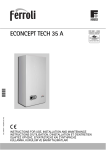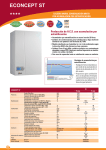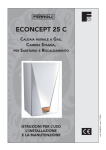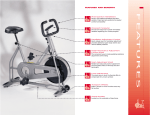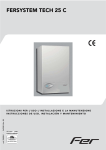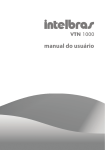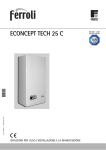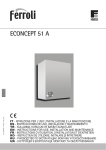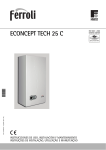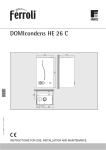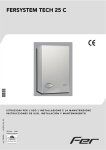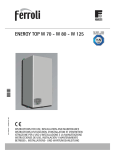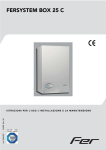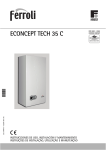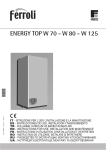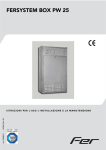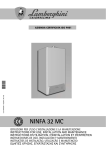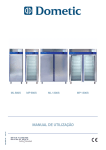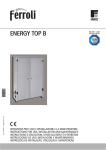Download ECONCEPT TECH 25 C
Transcript
cod. 3540I371 — 06/2008 (Rev. 00) 3540I371 ECONCEPT TECH 25 C INSTRUCTIONS FOR USE, INSTALLATION AND MAINTENANCE ECONCEPT TECH 25 C B • • • • • • Carefully read the warnings in this instruction booklet since they provide important information on safe installation, use and maintenance. This instruction booklet is an integral part of the product and must be carefully kept by the user for future reference. If the unit is sold or transferred to another owner or if it is to be moved, always make sure that the booklet accompanies the boiler so that it can be consulted by the new owner and/or installer. Installation and maintenance must be carried out by professionally qualified personnel, according to current regulations and the manufacturer's instructions. Incorrect installation or poor maintenance can cause damage or physical injury. The manufacturer declines any responsibility for damage caused by errors in installation and use or by failure to follow the manufacturer's instructions. Before carrying out any cleaning or maintenance operation, disconnect the unit from the electrical power supply using the switch and/or the special cut-off devices. • • • • • • In case the unit breaks down and/or functions poorly, deactivate it, do not make any attempt to repair it or directly intervene. Contact professionally qualified personnel. Any repair/replacement of products must only be carried out by qualified professional personnel using exclusively genuine parts. Failure to comply with the above could affect the safety of the unit. Periodical maintenance carried out by qualified personnel is essential for guaranteeing good operation of the unit. This unit must only be used for the purpose for which it was designed. Any other use is considered improper and therefore hazardous. After removing the packing, check the integrity of the contents. Packing materials must not be left within the reach of children as they are potentially hazardous. In case of doubt do not use the unit, and contact the supplier. The images shown in this manual are a simplified representation of the product. In this representation there may be slight, unimportant differences with the supplied product. B This symbol indicates "Caution" and is placed next to all safety warnings. Strictly follow these instructions in order to avoid danger and damage to persons, animals and things. A This symbols calls attention to a note or important notice. Declaration of conformity Manufacturer: FERROLI S.p.A. Address: Via Ritonda 78/a 37047 San Bonifacio VR Italy declares that this unit complies with the following EU directives: • • • • Gas Appliance Directive 90/396 Efficiency Directive 92/42 Low Voltage Directive 73/23 (amended by 93/68) Electromagnetic Compatibility Directive 89/336 (amended by 93/68) President and Legal Representative Cav. del Lavoro Dante Ferroli 2 cod. 3540I371 - 06/2008 (Rev. 00) EN ECONCEPT TECH 25 C 1 Operating instructions ............................................................................................................ 4 1.1 Introduction............................................................................................................................................. 4 1.2 Control panel .......................................................................................................................................... 4 1.3 Turning on and off .................................................................................................................................. 6 1.4 Adjustments............................................................................................................................................ 7 2 Installation .............................................................................................................................. 11 2.1 General Instructions ............................................................................................................................. 11 2.2 Place of installation .............................................................................................................................. 11 2.3 Plumbing connections .......................................................................................................................... 11 2.4 Gas connection .................................................................................................................................... 12 2.5 Electrical connections........................................................................................................................... 12 2.6 Fume ducts........................................................................................................................................... 14 2.7 Condensate drain connection............................................................................................................... 18 3 Service and maintenance...................................................................................................... 19 3.1 Adjustments.......................................................................................................................................... 19 3.2 Start-up................................................................................................................................................. 21 3.3 Maintenance ......................................................................................................................................... 21 3.4 Troubleshooting.................................................................................................................................... 23 4 Technical data and characteristics ...................................................................................... 25 4.1 Dimensions and connections ............................................................................................................... 25 4.2 General view and main components .................................................................................................... 26 4.3 Plumbing circuit .................................................................................................................................... 27 4.4 Technical data table ............................................................................................................................. 28 4.5 Diagrams .............................................................................................................................................. 29 4.6 Wiring diagram ..................................................................................................................................... 30 3540I371 cod. 3540I371 - 06/2008 (Rev. 00) 3 ECONCEPT TECH 25 C 1. Operating instructions 1.1 Introduction Dear Customer, Thank you for choosing ECONCEPT TECH 25 C, a FERROLI wall-mounted boiler featuring advanced design, cuttingedge technology, high reliability and quality construction. Please read this manual carefully since it provides important information on safe installation, use and maintenance. ECONCEPT TECH 25 C is a high-efficiency and low emissions, sealed chamber premix condensing heat generator for heating and domestic hot water production, running on natural gas or LPG and equipped with a microprocessor control system. The boiler shell consists of an aluminium laminar exchanger and a premix burner (ceramic) equipped with electronic ignition and ionisation flame control, modulating speed fan and modulating gas valve. 1.2 Control panel 8 1 2 9 5 15 7 10 eco comfort 11 reset 12 14 3 4 13 6 fig. 1 - Control panel Key 1= 2= 3= DHW temperature setting decrease button DHW temperature setting increase button Heating system temperature setting decrease button 4 = Heating system temperature setting increase button 5 = Display 6 = "Sliding Temperature" menu - Summer/Winter mode selection - Reset button 7 = Unit On/Off - Economy/Comfort mode selection button 8 = DHW symbol 9 = DHW operation 10 = Summer mode 11 = Multifunction indication (flashing during exchanger protection function) 12 = Eco (Economy) mode 4 13 = Heating operation 14 = Heating symbol 15 = Burner On and actual power (flashing during flame protection function) cod. 3540I371 - 06/2008 (Rev. 00) EN ECONCEPT TECH 25 C Indication during operation Heating A heating demand (generated by the Room Thermostat or Remote Timer Control) is indicated by flashing of the hot air above the radiator (details 13 and 14 - fig. 1). The display (detail 11 - fig. 1) shows the actual heating delivery temperature and during DHW standby time, the message “d2”. eco comfort eco comfort reset reset fig. 2 Domestic hot water (DHW) A DHW demand (generated by drawing domestic hot water) is indicated by flashing of the hot water under the tap (details 8 and 9 - fig. 1). The display (detail 11 - fig. 1) shows the actual DHW outlet temperature and during DHW standby time, the message “d1“. eco comfort eco comfort reset reset fig. 3 Comfort A Comfort demand (restoration of temperature inside the boiler), is indicated by flashing of the water under the tap (detail 9 - fig. 1). The display (detail 11 - fig. 1) shows the actual temperature of the water contained in the boiler. eco comfort reset fig. 4 EN cod. 3540I371 - 06/2008 (Rev. 00) 5 ECONCEPT TECH 25 C 1.3 Turning on and off Boiler lighting Switch on the power to the unit. eco comfort reset fig. 5 - Boiler lighting • • • • For the following 120 seconds the display will show FH which identifies the heating system air venting cycle. During the first 5 seconds the display will also show the card software release. Open the gas cock ahead of the boiler. When the message FH disappears, the boiler will be ready to operate automatically whenever domestic hot water is drawn or in case of a room thermostat demand. Turning the boiler off Press the button (detail 7 - fig. 1) for 5 seconds. eco comfort reset fig. 6 - Turning the boiler off When the boiler is turned off, the electronic board is still powered. Domestic hot water and heating operation are disabled. The antifreeze system remains activated. To relight the boiler, press the button (detail 7 fig. 1) again for 5 seconds. eco comfort reset fig. 7 The boiler will be immediately ready to operate whenever domestic hot water is drawn or in case of a room thermostat demand. 6 cod. 3540I371 - 06/2008 (Rev. 00) EN ECONCEPT TECH 25 C B The antifreeze system does not work when the power and/or gas to the unit are turned off. To avoid damage caused by freezing during long idle periods in winter, it is advisable to drain all water from the boiler, DHW circuit and system; or drain just the DHW circuit and add a suitable antifreeze to the heating system, complying with that prescribed in sec. 2.3. 1.4 Adjustments Summer/Winter changeover Press the button (detail 6 - fig. 1) for 2 seconds. eco comfort reset fig. 8 The display activates the Summer symbol (detail 10 - fig. 1): the boiler will only deliver domestic hot water. The antifreeze system remains activated. To deactivate Summer mode, press the button (detail 6 - fig. 1) again for 2 seconds. Heating temperature adjustment Operate the heating buttons of 90 °C. (details 3 and 4 - ) to adjustfig. 1the temperature from a min. of 20 °C to a max. eco comfort reset fig. 9 Domestic hot water (DHW) temperature adjustment Operate the DHW buttons of 55°C. (details 1 and 2 - fig. 1) to adjust the temperature from a min. of 40 °C to a max. eco comfort reset fig. 10 EN cod. 3540I371 - 06/2008 (Rev. 00) 7 ECONCEPT TECH 25 C Room temperature adjustment (with optional room thermostat) Using the room thermostat, set the temperature desired in the rooms. If the room thermostat is not installed the boiler will keep the heating system at its setpoint temperature. Room temperature adjustment (with optional remote timer control) Using the remote timer control, set the temperature desired in the rooms. The boiler unit will set the system water according to the required room temperature. For information on the remote timer control, please refer to its user's manual. ECO/COMFORT selection The unit is equipped with a function that ensures a high domestic hot water delivery speed and maximum comfort for the user. When the device is activated (COMFORT mode), the water contained in the boiler is kept hot, therefore ensuring immediate availability of hot water on opening the tap, without waiting times. The device can be deactivated by the user (ECO mode) by pressing the button (detail 7 - fig. 1). In ECO mode the display activates the ECO symbol (detail 12 - fig. 1). To activate COMFORT mode, press the button (detail 7 - fig. 1) again. Sliding temperature When the optional external probe is installed the boiler adjustment system works with "Sliding Temperature”. In this mode, the temperature of the heating system is adjusted according to the outside weather conditions, in order to ensure high comfort and energy saving throughout the year. As the outside temperature increases, the temperature of the heating system is decreased according to a fixed “compensation curve”. With Sliding Temperature adjustment, the temperature set with the heating buttons (details 3 and 4 - fig. 1) becomes the maximum system delivery temperature. It is advisable to set a maximum value to allow system adjustment throughout its useful operating range. The boiler must be adjusted at the time of installation by qualified personnel. Possible adjustments can in any case be made by the user to improve comfort. Compensation curve and curve offset Press the button (detail 6 - fig. 1) for 5 seconds to access the "Sliding temperature" menu; "CU" appears flashing (fig. 11). Operate the DHW buttons (details 1 and 2 - fig. 1) to adjust the required curve from 1 to 10 according to the characteristic (fig. 13). By setting the curve to 0, sliding temperature adjustment is disabled. eco comfort reset fig. 11 - Compensation curve 8 cod. 3540I371 - 06/2008 (Rev. 00) EN ECONCEPT TECH 25 C Press the heating buttons (fig. 12). Operate the DHW buttons characteristic (fig. 14). (details 3 and 4 - fig. 1) to access parallel curve offset; "OF" appears flashing (details 1 and 2 - fig. 1) to adjust parallel curve offset according to the eco comfort reset fig. 12 - Parallel curve offset Press the button (detail 6 - fig. 1) again for 5 seconds to exit the “Sliding Temperature” menu. If the room temperature is lower than the required value, it is advisable to set a higher order curve and vice versa. Proceed by increasing or decreasing in steps of one and check the result in the room. 90 85 80 10 9 8 7 6 5 4 70 3 60 2 50 1 40 30 20 20 10 0 -10 -20 fig. 13 - Compensation curves OFFSET = 20 OFFSET = 40 90 85 80 10 9 8 6 5 70 4 60 3 50 2 40 1 30 20 7 20 10 0 -10 -20 90 85 80 10 9 8 7 6 5 4 3 70 2 60 1 50 40 30 20 20 10 0 -10 -20 fig. 14 - Example of parallel compensation curve shift Timer Control (optional) is connected to the boiler, the above adjustments are managed accordA IfingthetoRemote that given in table 1. EN cod. 3540I371 - 06/2008 (Rev. 00) 9 ECONCEPT TECH 25 C Table. 1 Heating temperature adjustment Adjustment can be made from the Remote Timer Control menu and the boiler control panel. DHW temperature adjustment Adjustment can be made from the Remote Timer Control menu and the boiler control panel. Summer/Winter changeover Summer mode has priority over a possible Remote Timer Control heating demand. Eco/Comfort selection On disabling DHW from the Remote Timer Control menu, the boiler selects the Economy mode. In this condition, the button boiler panel is disabled. (detail 7 - fig. 1) on the On enabling DHW from the Remote Timer Control menu, the boiler selects the Comfort mode. In this condition it is possible select one of the two modes with the button Sliding Temperature (detail 7 - fig. 1) on the boiler panel. Both the Remote Timer Control and the boiler card manage Sliding Temperature adjustment: of the two, the boiler card Sliding Temperature has priority. Water system pressure adjustment The filling pressure with system cold, read on the boiler water gauge, must be approx. 1.0 bar. If the system pressure falls to values below minimum, the boiler card will activate fault F37 (fig. 15). eco comfort reset fig. 15 - Low system pressure fault Operate the filling cock (detail 1 - fig. 16) and bring the system pressure to a value above 1.0 bar. fig. 16 - Filling cock the system pressure is restored, the boiler will activate the 120-second air venting cycle indicated on the A Once display by FH. At the end of the operation always close the filling cock (detail 1 - fig. 16) 10 cod. 3540I371 - 06/2008 (Rev. 00) EN ECONCEPT TECH 25 C 2. Installation 2.1 General Instructions BOILER INSTALLATION MUST ONLY BE PERFORMED BY QUALIFIED PERSONNEL, IN ACCORDANCE WITH ALL THE INSTRUCTIONS GIVEN IN THIS TECHNICAL MANUAL, THE PROVISIONS OF CURRENT LAW, THE PRESCRIPTIONS OF NATIONAL STANDARDS AND LOCAL REGULATIONS AND THE RULES OF PROPER WORKMANSHIP 2.2 Place of installation The combustion circuit is sealed with respect to the place of installation, therefore the unit can be installed in any room. However, the place of installation must be sufficiently ventilated to prevent the creation of any dangerous conditions in case of even small gas leaks. This safety precaution is required by EEC Directive no. 90/396 for all gas units, including those with a so-called sealed chamber. Therefore the place of installation must be free of dust, flammable materials or objects or corrosive gases. The room must be dry and not subject to freezing. The boiler is arranged for wall mounting and comes standard with a hooking bracket. The wall fixing must ensure stable and effective support for the generator. is enclosed in a cabinet or mounted alongside, a space must be provided for removing the casing A Ifandtheforunitnormal maintenance operations 2.3 Plumbing connections The heating capacity of the unit must be previously established by calculating the building's heat requirement according to current regulations. The system must be provided with all the components for correct and regular operation. It is advisable to install on/off valves between the boiler and heating system allowing the boiler to be isolated from the system if necessary. B The safety valve outlet must be connected to a funnel or collection pipe to prevent water spurting onto the floor in case of overpressure in the heating circuit. Otherwise, if the drain valve is activated and floods the room, the boiler manufacturer cannot be held liable. Do not use the water system pipes to earth electrical appliances. Before installation, carefully wash all the pipes of the system to remove residuals or impurities that could affect correct operation of the unit. B A filter must be installed on the system return piping to prevent impurities or sludge from the system clogging and damaging the heat generators. The filter MUST be installed when replacing generators in existing systems. The manufacturer declines any liability for damage caused to the generator due to failure to install or inadequate installation of this filter. Make the relevant connections according to the diagram in sec. 4.1 and the symbols given on the unit. System water charcteristics In the presence of water harder than 25° Fr (1°F = 10ppm CaCO3), the use of suitably treated water is advisable in order to avoid possible scaling in the boiler. The treatment must not in any case reduce the hardness to values below 15°F (Decree 236/88 for uses of water intended for human consumption). Water treatment is indispensable in the case of very large systems or with frequent replenishing of water in the system. If partial or total emptying of the system becomes necessary in these cases, it is advisable to refill it with treated water. EN cod. 3540I371 - 06/2008 (Rev. 00) 11 ECONCEPT TECH 25 C Antifreeze system, antifreeze fluids, additives and inhibitors The boiler is equipped with an antifreeze system that turns on the boiler in heating mode when the system delivery water temperature falls under 6°C. The device will not come on if the electricity and/or gas supply to the unit are cut off. If it becomes necessary, it is permissible to use antifreeze fluid, additives and inhibitors only if the manufacturer of these fluids or additives guarantees they are suitable for this use and cause no damage to the heat exchanger or other components and/or materials of the boiler unit and system. It is prohibited to use generic antifreeze fluid, additives or inhibitors that are not expressly suited for use in heating systems and compatible with the materials of the boiler unit and system. 2.4 Gas connection B Before making the connection, ensure that the unit is arranged for operation with the type of fuel available and carefully clean all the pipes of the gas system to remove any residues that could affect good functioning of the boiler. The gas must be connected to the relative connector (see fig. 30) in conformity with current standards, with rigid metal pipes or with continuous flexible s/steel wall tubing, placing a gas cock between the system and the boiler. Make sure that all the gas connections are tight. The capacity of the gas meter must be sufficient for the simultaneous use of all equipment connected to it. The diameter of the gas pipe leaving the boiler does not determine the diameter of the pipe between the unit and the meter; it must be chosen according to its length and loss of head, in conformity with current standards. B 2.5 Electrical connections Do not use the gas pipes to earth electrical appliances. Connection to the electrical grid B The unit's electrical safety is only guaranteed when correctly connected to an efficient earthing system executed according to current safety standards. Have the efficiency and suitability of the earthing system checked by professionally qualified personnel. The manufacturer is not responsible for any damage caused by failure to earth the system. Also make sure that the electrical system is adequate for the maximum power absorbed by the unit, as specified on the boiler dataplate. The boiler is prewired and provided with a Y-cable and plug for connection to the electricity line. The connections to the grid must be made with a permanent connection and equipped with a bipolar switch whose contacts have a minimum opening of at least 3 mm, interposing fuses of max. 3A between the boiler and the line. It is important to respect the polarities (LINE: brown wire / NEUTRAL: blue wire / EARTH: yellow-green wire) in making connections to the electrical line. During installation or when changing the power cable, the earth wire must be left 2 cm longer than the others. B The user must never change the unit's power cable. If the cable gets damaged, switch off the unit and have it changed solely by professionally qualified personnel. If changing the electric power cable, use solely “HAR H05 VV-F” 3x0.75 mm2 cable with a maximum outside diameter of 8 mm. Room thermostat (optional) B 12 CAUTION: The room thermostat must have clean contacts. CONNECTING 230 V. TO THE TERMINALS OF THE ROOM THERMOSTAT WILL IRREPARABLY DAMAGE THE ELECTRONIC CARD. When connecting a remote timer control or a timer switch, do not take the power supply for these devices from their cut-out contacts. Their power supply must be taken with a direct connection from the mains or with batteries, depending on the kind of device. cod. 3540I371 - 06/2008 (Rev. 00) EN ECONCEPT TECH 25 C External probe (optional) Connect the probe to its respective terminals. The maximum permissible length for the boiler - external probe connection electrical cable is 50 m. A normal 2-wire cable can be used. The external probe should preferably be installed on the North, North-West wall or that facing the largest area of living room. The probe must never be exposed to the early morning sun or, insofar as possible, direct sunlight; protect it if necessary. In any case, the probe must not be installed near windows, doors, ventilation openings, flues or heat sources that could affect the reading. fig. 17 - External probe positioning not recommended Accessing the terminal block Follow the instructions given in fig. 18 to access the electrical connection terminal block. The layout of the terminals for the various connections is given in the wiring diagram in fig. 33. fig. 18 - Accessing the terminal block EN cod. 3540I371 - 06/2008 (Rev. 00) 13 ECONCEPT TECH 25 C 2.6 Fume ducts The unit is “C type" with sealed chamber and forced draught; the air inlet and fume exhaust must be connected to one of the exhaust/inlet systems indicated below. The unit is approved for operation with all the Cxy flue configurations specified on the dataplate (some setups are given by way of example in this section). Some configurations may be expressly limited or not permitted by local regulations, standards or laws. Before proceeding with installation, check and carefully observe the above-mentioned prescriptions. Also, comply with the provisions concerning the positioning of wall and/or roof terminals and the minimum distances from windows, walls, ventilation openings, etc. B This C-type unit must be installed using the fume exhaust and inlet pipes supplied by the manufacturer in accordance with UNI-CIG 7129/92. Failure to use them automatically invalidates every warranty and relieves the manufacturer of any liability. For fume exhaust pipes longer than 1 metre, during installation take into account the natural expansion of the A materials when the boiler is operating. To prevent deformations leave an expansion space of approx. 2-4 mm for every metre of pipe. 2 ÷ 4 mm fig. 19 - Expansion 14 cod. 3540I371 - 06/2008 (Rev. 00) EN ECONCEPT TECH 25 C Connection with coaxial pipes C33 C33 C13 fig. 20 - Examples of connection with coaxial pipes ( C13 C33 C13 = Air / = Fumes) Ø 127 Ø 60 Ø 80 120 147 120 142 Ø 60 Ø 100 041002X0 041006X0 Ø 100 For coaxial connection, fit the unit with one of the following starting accessories. For the wall hole dimensions, refer to sec. 4.1. Any horizontal sections of the fume exhaust must be kept sloping slightly towards the boiler, to prevent possible condensate from flowing back towards the outside and causing dripping. 041001X0 fig. 21 - Starting accessory for coaxial ducts Before proceeding with installation, check with table 2 that the maximum permissible length is not exceeded, bearing in mind that every coaxial bend gives rise to the reduction indicated in the table. For example, a Ø 60/100 duct comprising a 90° bend + 1 horizontal metre has a total equivalent length of 2 metres. Table. 2 - Max. length coaxial ducts Max. permissible length Coaxial 60/100 Coaxial 80/125 5m 15 m Reduction factor 90° bend 1m 0.5 m Reduction factor 45° bend 0.5 m 0.25 m EN cod. 3540I371 - 06/2008 (Rev. 00) 15 ECONCEPT TECH 25 C Connection with separate pipes C53 C33 C53 fig. 22 - Examples of connection with separate pipes ( B23 = Air / C13 = Fumes) For connection of separate ducts, fit the unit with starting accessory: 041003X0 fig. 23 - Starting accessory for separate ducts Before proceeding with installation make sure the maximum permissible length has not been exceeded, by means of a simple calculation: 1. Establish the layout of the system of split flues, including accessories and outlet terminals. 2. Consult the table 4 and identify the losses in meq (equivalent metres) of every component, according to the installation position. 3. Check that the sum total of losses is less than or equal to the maximum permissible length in table 3. Table. 3 - Max. length separate ducts Separate ducts Max. permissible length 16 75 meq cod. 3540I371 - 06/2008 (Rev. 00) EN ECONCEPT TECH 25 C Table. 4 - Accessories Losses in meq Air inlet Ø 80 Fume exhaust Vertical Horizontal 1.6 2.0 PIPE 1 m M/F 1KWMA83W 1.0 BEND 45° M/F 1KWMA65W 1.2 1.8 90° M/F 1KWMA01W 1.5 2.0 with test point 1KWMA70W 0.3 0.3 air, wall 1KWMA85A 2.0 - fumes, wall with antiwind 1KWMA86A - 5.0 Split air/fumes 80/80 1KWMA84U - 12.0 PIPE SECTION TERMINAL FLUE Connection to collective flues C83 C43 C43 fig. 24 - Examples of connection to flues ( = Air / = Fumes) If you are then going to connect the ECONCEPT TECH 25 C boiler to a collective flue or a single flue with natural draught, the flue must be expressly designed by professionally qualified technical personnel in conformity with the current standards and be suitable for airtight chamber units equipped with a fan. In particular, flues must have the following characteristics: • • • • • • • • • EN Be sized according to the method of calculation stated in the current standards. Be airtight to the products of combustion, resistant to the fumes and heat and waterproof for the condensate. Have a circular or quadrangular cross-section, with a vertical progression and with no constrictions. Have the ducts conveying the hot fumes adequately distanced or isolated from combustible materials. Be connected to just one unit per floor. Be connected to just one type of unit (or all and only forced draught units or all and only natural draught units). Have no mechanical suction devices in the main ducts. Be at a lower pressure, all along their length, under conditions of stationary operation. Have at their base a collection chamber for solid materials or condensation equipped with a metal door with an airtight closure. cod. 3540I371 - 06/2008 (Rev. 00) 17 ECONCEPT TECH 25 C 2.7 Condensate drain connection The boiler is equipped with a trap to drain condensate. Fit the inspection connection A and the flexible tube B, pressing it in about 3 cm and securing it with a clamp. Fill the trap with approx. 0.5 l. of water and connect the flexible tube to the elimination system. fig. 25 - Condensate drain connection 18 cod. 3540I371 - 06/2008 (Rev. 00) EN ECONCEPT TECH 25 C 3. Service and maintenance All adjustment, conversion, start-up and maintenance operations described below must only be carried out by Qualified Personnel (meeting the professional technical requirements prescribed by current regulations) such as those of the Local AfterSales Technical Service. FERROLI declines any liability for damage and/or injury caused by unqualified and unauthorised people tampering with the unit. 3.1 Adjustments Gas supply conversion The unit can operate on Natural Gas or LPG and is factory-set for use with one of these two gases, as clearly shown on the packing and on the dataplate. Whenever a different gas to that for which the unit is arranged has to be used, a conversion kit will be required, proceeding as follows: 1. 2. 3. 4. 5. 6. 7. 8. Remove the casing. Open the sealed chamber. Release the fixing clip C and remove the gas pipeA from the fan - venturi assembly. Replace the nozzle B inserted in the gas pipe with that contained in the conversion kit. Reassemble the gas pipe A with the clip and check the seal of the connection. Apply the plate contained in the conversion kit, near the dataplate. Refit the sealed chamber and casing. Modify the parameter for the type of gas: • • • • • switch the boiler to standby mode press the DHW buttons (detail 1 and 2 - fig. 1) for 10 seconds: the display shows “P01“ flashing. press the DHW buttons (details 1 and 2 - fig. 1) to set the parameter 00 (for operation with natural gas) or 01 (for operation with LPG). press the DHW buttons (details 1 and 2 - fig. 1) for 10 seconds. the boiler will return to the standby mode 9. Using a combustion analyser connected to the boiler fume outlet, check that the CO 2 content in the fumes (with the boiler operating at max. and min. output) complies with the value given in the technical data table for the corresponding gas type. fig. 26 - Gas supply conversion EN cod. 3540I371 - 06/2008 (Rev. 00) 19 ECONCEPT TECH 25 C Activating TEST mode Press the heating buttons (details 3 and 4 - ) at the same time for 5fig. 1seconds to activate TEST mode. The boiler lights at the maximum heating power set as described in the following section. The heating symbol (detail 14 - fig. 1) and DHW symbol (detail 8 - fig. 1) flash on the display; the heating power will be displayed alongside. IIII IIIIIIII IIIIIIII IIIII I I I II II I I I I II II I III III fig. 27 - TEST mode (heating power = 100%) To deactivate TEST mode, repeat the activation sequence. In any case, the TEST mode is disabled automatically after 15 minutes. Heating power adjustment To adjust the heating power, switch the boiler to TEST mode (see sec. 3.1). Press the heating buttons tails 3 and 4 - fig. 1) to increase or decrease the power (min. = 00 - max. = 100). Press the RESET button seconds; the max. power will remain that just set. Exit TEST mode (see sec. 3.1). 20 cod. 3540I371 - 06/2008 (Rev. 00) (dewithin 5 EN ECONCEPT TECH 25 C 3.2 Start-up B Checks to be made at first lighting, and after all maintenance operations that involved disconnection from the systems or an operation on safety devices or parts of the boiler: Before lighting the boiler • • • • • • • • • Open any on-off valves between the boiler and the systems. Check the tightness of the gas system, proceeding with caution and using a soap and water solution to detect any leaks in connections. Check correct prefilling of the expansion tank (ref. sec. 4.4). Fill the water system and make sure all air contained in the boiler and the system has been vented, by opening the air vent valve on the boiler and any vent valves on the system. Fill the condensate trap and check correct connection of the condensate elimination system. Make sure there are no water leaks in the system, DHW circuits, connections or boiler. Check correct connection of the electrical system and efficiency of the earthing system Make sure the gas pressure value for heating is that required. Make sure there are no flammable liquids or materials in the immediate vicinity of the boiler Checks during operation • • • • • • • • • • Turn the unit on as described in sec. 1.3. Make sure the fuel circuit and water systems are tight. Check the efficiency of the flue and air-fume ducts while the boiler is working. Check the correct tightness and functionality of the condensate elimination system and trap. Make sure the water is circulating properly between the boiler and the systems. Make sure the gas valve modulates correctly in the heating and domestic hot water production phases. Check proper boiler lighting by doing several tests, turning it on and off with the room thermostat or remote control. Using a combustion analyser connected to the boiler fume outlet, check that the CO2 content in the fumes, with the boiler operating at max. and min. output, corresponds to that given in the technical data table for the corresponding type of gas. Make sure the fuel consumption indicated on the meter matches that given in the technical data table on sec. 4.4. Check the correct programming of the parameters and carry out any necessary customization (compensation curve, power, temperatures, etc.). 3.3 Maintenance Periodical check To keep the unit working properly over time, it is necessary to have qualified personnel make an annual check that includes the following tests: • • • • • • • • • • • • The control and safety devices (gas valve, flow meter, thermostats, etc.) must function correctly. The fume extraction circuit must be fully efficient. The airtight chamber must be sealed The air-fume end piece and ducts must be free of obstructions and leaks The condensate evacuation system must be efficient with no leakage or obstructions. The burner and exchanger must be clean and free of scale. When cleaning, do not use chemical products or wire brushes. The electrode must be free of scale and properly positioned. The gas and water systems must be airtight. The water pressure in the cold water system must be about 1 bar; otherwise, bring it to that value. The circulation pump must not be blocked. The expansion tank must be filled. The gas flow and pressure must correspond to that given in the respective tables. The boiler casing, panel and aesthetic parts can be cleaned with a soft damp cloth, possibly soaked in soapy A water. Do not use any abrasive detergents and solvents. EN cod. 3540I371 - 06/2008 (Rev. 00) 21 ECONCEPT TECH 25 C Opening the casing To open the boiler casing (fig. 28): 1. Undo the screws (1) 2. Open, turning the casing (2) 3. Lift and remove the casing (3) 3 comeco fort res et 1 2 0 comeco fort 3 BA res R et 1 4 2 0 3 BA R 4 2 1 1 fig. 28 - Opening the casing Combustion analysis It is possible to analyse the combustion through the air sampling (detail 2) and fume sampling (detail 1) points shown in fig. 29. To take the measurement: 1. 2. 3. 4. 5. Open the air and fume sampling points Insert the probes Press the"+" and "-" buttons for 5 seconds to activate TEST mode Wait 10 minutes for the boiler to stabilise Take the measurement For natural gas the CO2 reading must be between 8.7 and 9 %. For LPG the CO2 the reading must be between 9.5 and 10 %. A Analyses made with an unstabilised boiler can cause measurement errors. 2 1 2 1 fig. 29 - Combustion analysis 22 cod. 3540I371 - 06/2008 (Rev. 00) EN ECONCEPT TECH 25 C 3.4 Troubleshooting Diagnostics In case of operation faults or problems, the display flashes and the fault identification code appears. There are faults that cause permanent shutdown (marked with the letter “A”): to restore operation just press the RESET button (detail 8 - fig. 1) for 1 second or RESET on the optional remote timer control if installed; if the boiler fails to start, it is necessary to first eliminate the fault. Other faults (marked with the letter “F”) cause temporary shutdowns that are automatically reset as soon as the value returns within the boiler's normal working range. Table. 5 - List of faults Fault code A01 A02 A03 Fault Possible cause Cure No gas Check the regular gas flow to the boiler and that the air has been eliminated from the pipes Ignition/detection electrode fault Check the wiring of the electrode and that it is correctly positioned and free of any deposits Faulty gas valve Check the gas valve and replace it necessary Insufficient gas supply pressure Check the gas supply pressure The burner fails to light Flame present signal with burner off Overtemperature protection activated Trap clogged Check the trap and clean it if necessary Electrode fault Check the ionisation electrode wiring Card fault Check the card Heating sensor damaged Check the correct positioning and operation of the heating sensor No water circulation in the system Check the circulating pump Air in the system Vent the system See fault F07 A04 Fume exhaust duct safety activated Fault F07 generated 3 times in the last 24 hours A05 Fan protection activated Fault F15 generated for 1 hour (consecutive) Ionisation electrode fault A06 F07 No flame after ignition stage (6 times in 4 minutes) High fume temperature See fault F15 Check the position of the ionisation electrode and replace it if necessary Flame unstable Check the burner Gas valve Offset fault Check the Offset adjustment at minimum power air/fume ducts obstructed Remove the obstruction from the flue, fume exhaust ducts and air inlet and terminals Trap clogged Check the trap and clean it if necessary Flue partially obstructed or insufficient Check the efficiency of the flue, fume exhaust ducts and outlet terminal Fume sensor position Check the correct positioning and operation of the fume sensor Sensor damaged F10 Delivery sensor 1 fault Wiring shorted Check the wiring or replace the sensor Wiring disconnected Sensor damaged F11 Return sensor fault Wiring shorted Check the wiring or replace the sensor Wiring disconnected Sensor damaged F12 DHW sensor fault Wiring shorted Check the wiring or replace the sensor Wiring disconnected EN cod. 3540I371 - 06/2008 (Rev. 00) 23 ECONCEPT TECH 25 C Fault code Fault Possible cause Cure Sensor damaged F13 Fume sensor fault Wiring shorted Check the wiring or replace the sensor Wiring disconnected Sensor damaged F14 Delivery sensor 2 fault Wiring shorted Check the wiring or replace the sensor Wiring disconnected No 230V power supply Check the wiring of the 3-pole connector F15 Fan fault Tachometric signal interrupted Check the wiring of the 5-pole connector Fan damaged Check the fan F34 Supply voltage under 170V Power supply trouble Check the electrical system F35 Mains frequency fault F37 24 Incorrect system water pressure Power supply trouble Check the electrical system Pressure too low Fill the system Water pressure switch not connected or damaged Check the sensor Probe damaged or wiring shorted Check the wiring or replace the sensor Probe disconnected after activating the sliding temperature Reconnect the external probe or disable the sliding temperature F39 External probe fault A41 Sensor positioning Delivery sensor disconnected from the pipe Check the correct positioning and operation of the heating sensor F42 Heating sensor fault Sensor damaged Replace the sensor cod. 3540I371 - 06/2008 (Rev. 00) EN ECONCEPT TECH 25 C 4. Technical data and characteristics 195 4.1 Dimensions and connections 80 120 330 120 80 700 400 3 4 6 5 82.5 76 54 51 231 2 179 1 80.5 56 fig. 30 - Dimensions and connections 1= 2= 3= EN Heating system delivery Domestic hot water outlet Gas inlet 4= 5= 6= cod. 3540I371 - 06/2008 (Rev. 00) Domestic cold water inlet Heating system return Safety valve drain 25 ECONCEPT TECH 25 C 4.2 General view and main components 29 201 191 5 56 16 82 188 22 161 278 19 196 250 14 194 186 42 36 114 193 32 39 95 136 37 10 8 44 7 9 74 11 fig. 31 - General view 5 7 8 9 10 11 14 16 19 22 29 32 36 37 39 42 26 Sealed chamber Gas inlet Domestic hot water outlet Domestic cold water inlet System delivery System return Safety valve Fan Combustion chamber Main burner Fume outlet manifold Heating circulating pump Automatic air vent Cold water inlet filter Flow regulator DHW temperature probe 44 56 74 82 95 114 136 161 186 188 191 193 194 196 250 278 cod. 3540I371 - 06/2008 (Rev. 00) Gas valve Expansion tank System filling cock Detection electrode Diverter valve Water pressure switch Flowmeter Condensing heat exchanger Return sensor Ignition electrode Fume temperature sensor Trap DHW circuit exchanger Condensate tray System delivery filter Double sensor (Safety + Heating) EN ECONCEPT TECH 25 C 4.3 Plumbing circuit 16 161 278 56 196 193 154 44 186 194 114 36 250 95 32 14 241 74 136 37 42 10 8 7 9 11 fig. 32 - Plumbing circuit 7 8 9 10 11 14 16 32 36 37 42 44 56 EN Gas inlet Domestic hot water outlet Domestic cold water inlet System delivery System return Safety valve Fan Heating circulating pump Automatic air vent Cold water inlet filter DHW temperature probe Gas valve Expansion tank 74 95 114 136 154 161 186 193 194 196 241 250 278 cod. 3540I371 - 06/2008 (Rev. 00) System filling cock Diverter valve Water pressure switch Flowmeter Condensate outlet pipe Condensing heat exchanger Return sensor Trap DHW circuit exchanger Condensate tray Automatic bypass System delivery filter Double sensor (Safety + Heating) 27 ECONCEPT TECH 25 C 4.4 Technical data table The column on the right gives the abbreviation used on the dataplate. Data Unit Value Max. heating capacity kW 25.2 (Q) Min. heating capacity kW 5.3 (Q) Max. Heat Output in heating (80/60°C) kW 24.6 (P) Min. Heat Output in heating (80/60°C) kW 5.2 (P) Max. Heat Output in heating (50/30°C) kW 26.6 Min. Heat Output in heating (50/30°C) kW 5.7 Max. DHW heating capacity kW 27 Min. DHW heating capacity kW 5.3 Max. Heat Output in hot water production kW 26.5 Min. Heat Output in hot water production kW 5.2 mbar 20 Max. gas delivery G20 3 m /h 2.86 Min. gas delivery G20 3 m /h 0.56 Gas supply pressure G31 mbar 37 Gas supply pressure G20 Max. gas delivery G31 kg/h 2.11 Min. gas delivery G31 kg/h 0.41 Efficiency class directive 92/42 EEC - NOx emission class - 5 (NOx) Max. working pressure in heating bar 3 (PMS) Min. working pressure in heating bar 0.8 °C 95 Heating water content litres 1.5 Heating expansion tank capacity litres 8 Heating expansion tank prefilling pressure bar 1 Max. working pressure in hot water production bar 9 Max. heating temperature Min. working pressure in hot water production bar 0.25 Hot water content litres 0.3 DHW flowrate Δt 25°C l/min 15.2 DHW flowrate Δt 30°C l/min 12.7 Protection rating Power supply voltage IP V/Hz (D) X5D W 120 Electrical absorption in hot water production W 120 Empty weight kg 37 C13-C23-C33-C43-C53C63-C83-B23-B33 PIN CE 28 (PMW) 230V/50Hz Electrical absorption Type of unit (tmax) 0063BR3161 cod. 3540I371 - 06/2008 (Rev. 00) EN ECONCEPT TECH 25 C 4.5 Diagrams Loss of head/Head of circulators H [m H2O] 7 6 3 5 2 A 4 3 1 2 1 0 0 500 1.000 1.500 2.000 Q [l/h] A Boiler losses of head 1 - 2 - 3 Circulator speed EN cod. 3540I371 - 06/2008 (Rev. 00) 29 ECONCEPT TECH 25 C 4.6 Wiring diagram A 138 188 186 82 1 2 3 4 5 6 16 L N 230V 50Hz 32 T° T° 16 DBM04A 278 191 44 GND OUT +5V 136 114 42 95 139 72 fig. 33 - Wiring diagram Caution: Before connecting the room thermostat or the remote timer control, remove the jumper on the A terminal block. 16 32 42 44 72 82 95 114 136 138 139 30 Fan Heating circulator Tap water temperature sensor Gas valve Room thermostat Detection electrode Diverter valve Water pressure switch Flow meter External sensor Remote timer control 186 188 191 278 A cod. 3540I371 - 06/2008 (Rev. 00) Return sensor Ignition electrode Fume temperature sensor Double sensor (heating + safety) Flow meter ON/OFF contact EN FERROLI S.p.A. Via Ritonda 78/a 37047 San Bonifacio - Verona - ITALY www.ferroli.it































